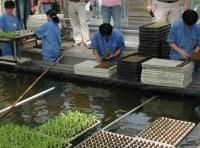
Faced with feeding every fifth person on the planet with less than one-tenth of the world’s farmland, Beijing has been pumping hundreds of millions of sino-dollars into transgenic crop research and development.
The plants, whose DNA is altered with genetic material that programs them with traits like pest and drought resistance, are helping farmers yield much more food and commodities at a lower cost – especially as farmland is slowly being lost to development and climate change.
But the real breakthrough came with the adoption of new hydroponic growth techniques; combined with genetically optimized strains, yields have increased exponentially, even outdoors and in relatively unprotected areas. Farmers are no longer subsistence producers.
In fact, modern organic hydro practices – in essence controlled container gardening – with specialized growth mediums and fungal concoctions customized to the high-tech crops from the biotech projects, have reversed China’s continual shortage of staple foods. Now agricultural labor is truly productive, and China can look forward to exporting surplus food.
Will the long-term effect of this step-change in Chinese food production create havoc for the very population it was intended to help in the first place?
ANALYSIS >> SYNTHESIS: How this scenario came to be
Feeding the hungry millions
What do you do when you have a huge surplus of dollars, but not enough food? You turn to science. Modern farming techniques and agricultural science averted the Malthusian prediction of global famine. But there are still regional problems, most notably in Africa and Asia. Advanced bio-technology and even more radical production processes are providing the solution.
Per Pinstrup-Andersen, a Cornell professor of food, argues that the food system is broken and needs to be fixed. “There are 850 million food-insecure people, and several hundred million obese people. Clearly the system is broken.”
But fixing the system in China with disruptive technology could have far-reaching consequences for the economic stability of the region.
2007: Food safety crisis
Dozens of people die in China because of poor quality or fake food and drugs, sparking widespread international fears about the safety of Chinese exports. US inspectors blame exported Chinese pet food ingredients, contaminated with melamine, for the deaths of cats and dogs in North America.
The former head of China’s State Food and Drug Administration, Zheng Xiaoyu, is executed for corruption, after being convicted of taking US$ 850,000 in bribes linked to sub-standard medicines.
2008: Snow crisis affects crops
The heaviest snowfalls in 50 years hit central and southern China, the regions that provide most of the country’s winter fruit and vegetables. “The impact of the snow disaster on winter crop production is extremely serious,” says Chen Xiwen, the deputy director of the Chinese Communist Party’s financial group. “The impact on fresh vegetables and on fruit in some places has been catastrophic.”
“With economic growth, we see rapidly changing food preferences and increasing demand for high standards of food quality. By 2010 China will have to produce 500 million tones of grains to meet domestic demand. The current production is about 480 million tons from 105 million ha of arable land. However this increase will have to come from shrinking land, water and other natural resources,” says Professor Kadambot Siddique.
Something has to be done to avert a food crisis, and the agricultural scientists are doing it, with genetic engineering and hydroponic techniques as their technology solutions.
2009: Biotech boom
The reluctance of China to push GM foods in the face of international criticism and the legacy of the 2008 snowstorms have resulted in a real food production deficit. Food imports have skyrocketed, and the effect on China’s trade surplus is severe.
China accelerates the pace of its biotech research with one goal in mind – achieve food security for the People, and let the rest of the world make peace with that fact. Biotech investments boom, and farmers are ‘encouraged’ to adopt the new improved crops, for the good of the nation.
2011: Hydroponic happiness
Hydroponics, long known to produce higher, better quality yields for urban producers, expands to the provinces. After all, rice paddies are a form of hydroponics, so the practice is not entirely new. But scientific, organic based hydro production, combined with biotech crops that are more hardy and grow faster, gives a double bonus: hydroponic happiness!
2012: China exports staple foods
Incredibly, from being a nett importer of crops and food for years, China has turned into a major supplier in the region. There are still products deemed ‘illegal’ in Europe and the Americas, but Asia has embraced the new crops and produce coming out of China. In real terms, global food prices resume their decades-old decline.
There is one area of concern, though. As an increasing proportion of the rural population migrates to the cities in search of better jobs, and farms become more efficient and productive, agriculture in China could leap into the 21st century. Such radical disruption would leave millions of farm workers looking for another way to earn a living, accelerating the urbanization cycle yet again. Perhaps that is an inevitable consequence of progress?
Warning: Hazardous thinking at work
Despite appearances to the contrary, Futureworld cannot and does not predict the future. Our Mindbullets scenarios are fictitious and designed purely to explore possible futures, challenge and stimulate strategic thinking. Use these at your own risk. Any reference to actual people, entities or events is entirely allegorical. Copyright Futureworld International Limited. Reproduction or distribution permitted only with recognition of Copyright and the inclusion of this disclaimer.
